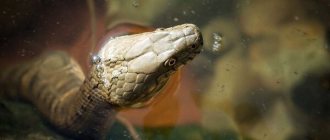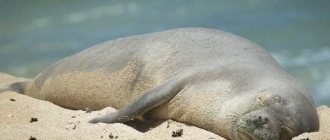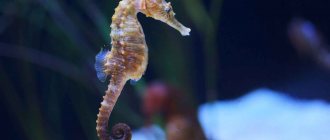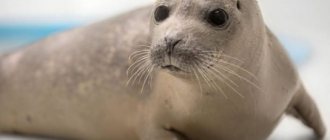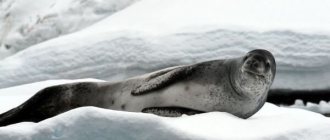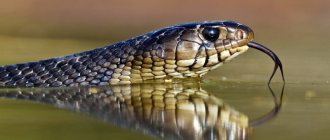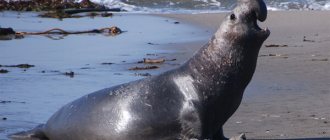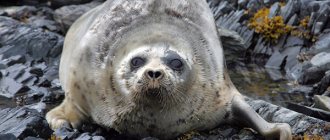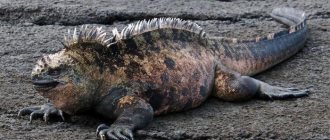Seals are related, but are in different taxonomic families.
- The so-called earless (true) seals are members of the Canidae family - Phocidae.
- Sea lions and seals are members of the family Otariidae (Steller sea lions).
- Walruses belong to the Walrus family.
The main difference between earless and eared seals is their ears.
- Sea lions have external ear flaps. These folds of skin are designed to protect the ear from water when the seal swims or dives.
- “True” seals have no external ears at all. You have to get very close to them to see the tiny holes on the sides of the seal's smooth head.
Another difference between seal groups is their rear flippers:
In real seals, the back flippers do not bend or tuck forward, but only backward. This prevents them from "walking" on the ground. They move on land using wave-like body movements.
Steller sea lions (fur seals and sea lions) can move on land using their back legs (flippers).
Third difference:
- Seals - they were named so because they have thick fur.
- True seals have only thin fur.
Fourth difference:
- Sea lions are noisy animals.
- Real seals are much quieter - their vocalizations resemble soft grunts.
There are 18 species of true seals and 16 species of eared seals.
The largest representative of true seals is the southern elephant seal. A massive male, weighing up to 8,500 pounds. (3,855.5 kg). Female elephant seals are much smaller, but still weigh more than a 2,000-pound car.
Males measure about 20 feet (6 meters) in length, with females measuring about half that length.
- Sea lion photo
The smallest representative of true (earless) seals is the seal. The seal has an average body length of 5 feet (1.5 m) and weighs from 110 to 150 pounds (50 to 70 kg). Unlike other seals, male and female seals are approximately the same size.
The seal is the most common seal species in the Arctic, according to a study by the National Oceanic and Atmospheric Administration (NOAA).
Of the 16 species of eared seals, seven are species of sea lions.
One of the most famous species, according to NOAA, is the California sea lion. In the wild, these animals live along the west coast of North America. They can often be seen basking on beaches and piers.
Males average about 700 pounds (315 kg) and can reach weights of over 1,000 pounds (455 kg). Females weigh on average 240 pounds (110 kg).
Natural environment of seals (seals)
True seals usually live in the cold ocean waters of the Arctic and off the coast of Antarctica.
The harp seal, ringed seal, akiba, Icelandic hooded seal, bearded seal, spotted seal, bearded walrus and lionfish live in the Arctic.
Crabeater, Weddell, leopard seals and Ross seals live in Antarctica.
- Rare animals from the Red Book. African lion
Fur seals and sea lions live in the North Pacific Ocean between Asia and North America, and off the coasts of South America, Antarctica, South West Africa and southern Australia. They can spend about two years in the open ocean before returning to their breeding grounds.
Some seals make caves in the snow. Others never leave the ice and poke breathing holes in the ice.
What do seals eat?
Seals primarily hunt fish, but they also eat eel, squid, octopus and lobster.
Leopard seals are capable of eating penguins and small seals.
The gray seal is capable of eating up to 10 pounds (4.5 kg) of food per day. He sometimes skips meals for several days in a row, and lives off the energy of stored fat. And often it stops feeding completely - during the mating season it does not feed for several weeks.
All pinnipeds - from true seals (earless) to eared seals (steller sea lions) and walruses (tusked odobenids) - are carnivores. They are related to dogs, coyotes, foxes, wolves, skunks, otters and bears.
How do Squirrels appear?
When mating season arrives, male seals will make deep guttural sounds to attract the attention of females. The male seal also calls other males to a duel using sounds.
Seals are very territorial animals when it comes to mating. They will fight for the right to mate, striking and biting each other. The winner gets the opportunity to mate with 50 females in their area.
The female's pregnancy lasts about 10 months. When they feel it is time to give birth, some of them dig nests in the sand, where they give birth to their young. Other seals lay their babies directly on the iceberg, on the snow.
- Description of the Barbary Lion from the Red Book
Squirrels are the name given to seal puppies.
Seals and sea lions only have one pup per year. Mothers will feed the squirrels on the ground until they develop waterproof fur. This may take about 1 month.
Females will mate and become pregnant again as soon as her squirrel is weaned.
Males are not able to mate until they are 8 years old because they need to be tall enough and strong enough to win a mating fight.
A few other facts about seals
All pinnipeds - seals, sea lions and walruses - are protected under the Marine Mammal Protection Act.
Most seals are not considered endangered according to the International Union for Conservation of Nature (IUCN) Red List.
However, there are a few exceptions.
The Caribbean seal was declared extinct in 2008.
- The Galapagos seal and the monk seal are both critically endangered.
- Some local groups, such as Gray seals in the Baltic Sea, are also at risk.
- Northern fur seals and hooded seals are also vulnerable.
Northern seals, Baikal seals and Ursula seals are also vulnerable animals. They are being bred at the New England Aquarium in Boston.
The crabeater seal, among seal species, has the largest population in the world. It is estimated that there are up to 75 million individual individuals.
The Elephant Seal has what is called "smoker's blood" - it has the same amount of carbon monoxide in its blood as a person who smokes 40 or more cigarettes a day. Scientists believe that this high level of gas in the blood protects them when they dive into the deep levels of the ocean.
Harp seals can stay underwater for up to 15 minutes.
The Weddell Seal results are even more impressive. Their record for staying underwater is 80 minutes. They only come up to grab air when they find holes in the layers of ice above the ocean.
California's Farallones National Marine Sanctuary is home to one-fifth of the world's seals. These marine mammals believe they have found a safe haven within the sanctuary.
Whales, dolphins and porpoises are cetaceans
Unicorn of the ocean - lifestyle of the whale Narwhal
Octopus is an active Predator
Sea lion - representatives of the eared seal family received their name due to their close resemblance to land lions. Male sea lions make a roar similar to that of the African lion. On their heads you can see the same shaggy manes. A pinniped (in Latin, “with legs like fins”) is streamlined, bulky, but flexible and slender, capable of reaching more than two meters in length. Let's get to know the marine life better in the article.
Sea lion - description and characteristics
Many people are interested in how much an adult sea lion weighs? The weight of the flipper mammal reaches 300 kg. Although the sea lion is quite bulky and looks too big and clumsy, it feels great for its weight. Female sea lions are much smaller than males by several times - on average 90 kg. The animal's head is small, externally reminiscent of a dog's head: an elongated, flexible neck, huge bulging eyes. There are large, dense whiskers on the muzzle. On the top of the head of a lion there is a real hairstyle - a crest.
The fur of sea creatures has a brown-black tint. The coat is quite short and sparse, so it is not particularly valued, unlike the fur of fur seals. Thanks to the presence of thick limbs-flippers, animals move deftly along the shore. Their relatives, seals, are not as nimble as lions. The body of animals is much more plastic than that of their relatives.
Sea lions easily overcome long distances in the water and show real acrobatic sketches. With the help of flippers, they professionally maneuver in the expanses of water and easily redirect their bulky body in any direction. In this way, obtaining food is not difficult, and the marine life has won the title of successful getter. When going in search of food, a lion can swim several kilometers from the shore.
kalan-dmitriy_utkin511108.jpg
Sea otter.
Photo: Dmitry Utkin A predatory marine mammal of the mustelid family. The length reaches one and a half meters, weight – 45 kg. It has the thickest fur among marine mammals. At the same time, the sea otter has practically no fat layer - this is the case when the excuse “I’m just fluffy” works!
Sea otters care for their young for a year from birth. Interestingly, the fur of babies is even thicker and fluffier than that of adults; it allows them not to drown in water. Mothers carry their babies on their chests, floating on their backs, and when they need to dive for prey, they simply leave the babies to sleep on the surface of the water. Interestingly, sea otters often hold their paws in their sleep to avoid being carried away by the current.
Sea Lion Habitat
Typically, lions settle on sea and ocean coasts, regardless of coverage. These can be rocky shores and sandy beaches. It can even be found in grass thickets.
Depending on the type of lion, animals can live in different areas:
It is also worth mentioning that marine life has long found its place in dolphinariums and circuses. A fur seal and a sea lion take part in show performances in aquariums and learn to perform various tricks. It is often believed that these cute animals are absolutely safe. Is a sea lion a predator? In the wild, a 300-kilogram trickster can be quite dangerous. The sea lion is a predator, quite aggressive. There are cases when they attacked fishermen and swimmers. There are even more known cases of lion attacks than shark attacks.
Like all relatives, predators live in herds, but their numbers are not as high as those of their comrades - seals. Some species can swim into open waters for a long time and not return to shore for several days. Therefore, when traveling long distances on a ship, you can see these animals in the middle of the ocean or sea.
Sea lions prefer to stay in the places they initially chose, without “wandering” from place to place. They live several tens of kilometers from land and communicate with each other using sound calls. Their voices are similar to the roar of land lions.
kosatka-robert_pittman-wiki-1280px-killerwhales_jumping.jpg
Killer whale.
Photo from wikipedia.org “Despite the fact that there are many times fewer carnivorous killer whales than fish-eating ones, they are not included in the Red Book. And they can be caught, for example, in aquariums. Anyone familiar with killer whales is against this. It is a crime to keep such highly intelligent creatures in captivity. It is simply impossible to create suitable conditions for them; they languish. All animals (orcas) in aquariums are sick, both physically and mentally. In nature, there is not a single case of killer whale attacking a person, and in captivity they very often attack their trainers. Orcas are taken from their families as babies, and the family will fight for its baby to the last, often to the death. Nobody talks about this, but the capture of killer whales is a monstrous spectacle. Please don’t go to aquariums,” said Svetlana Artemyeva.
What does a sea lion eat?
What does the inhabitant of the “big” waters, the sea lion, eat? It feeds on seafood: fish, octopuses, crayfish and any edible little things that come across along the way. They find prey at the bottom of the sea and ocean, at a depth of up to 100 meters. When a lion runs into a hedgehog fish, it swells to such a size that the lion cannot bite through it with its limited mouth.
The fish are chased at high speed, maneuvering between shells, algae and sea caves. In the expanses of water, lions move as easily as birds fly across the sky, actively rowing with their forelimbs and hind flippers.
Marine inhabitants do not accumulate large layers of fat and do not eat in reserve. They eat fresh seafood every day and have no problems finding food.
If marine mammals are on a hill, they can safely jump from it into the water from a height of up to 20 meters. The favorite delicacy, one of the varieties of lions - sea lions, are: herring, pollock, capelin, halibut, gobies, flounder. The eared family can feed on seaweed and octopuses. Since a lion is a predator, it can even attack a shark. Adult males, if they are very hungry, can attack the penguin.
Some fishermen testify that sea lions have attacked their catch.
kalan-andrey_sidorov578567.jpg
Sea otter.
Photo: Andrey Sidorov Sea otters can use tools to obtain food. For example, animals use small pebbles to crack shells. If a sea otter finds a particularly convenient pebble, ideal in shape and weight, it becomes its favorite: the sea otter uses only it, storing the pebble in a fold on its chest between its front legs, like in a pocket. Sea otters feed mainly on mollusks and crustaceans.
One of the factors that threatens sea otters even in protected areas is ocean pollution. When the fur gets dirty, its insulating properties are lost, and the sea otter can die from the cold.
Antur, or island seal
Sea lion breeding
The mating season occurs once a year right on the shores where sea lions live. They behave much calmer than, for example, fur seals. Males occupy the beach territory and protect it from strangers. Sometimes sea lions fight with competitors, trying to win their rights to females. Females gather in whole herds and wait to see who will become the strongest inseminating male.
Sometimes battles reach large-scale proportions. However, there is no death or bloodshed. Although, as with everything, there are exceptions. When young males want to penetrate a herd of older females, large males protect their harem. Violent skirmishes then occur where some lions may emerge from the fight with injuries.
Each male gathers around a dozen females. The owner is vigilant to ensure that his “ladies” do not look at other males and especially do not have relationships with them. Those individuals that do not reproduce move away from the rest of the rookery. When the female comes into heat, she lies down next to the chosen male and presses tightly against his body. Without taking their eyes off the lion, they begin to mate. This happens in water or on land within an hour.
Pregnancy of lionesses lasts 12 months. They give birth to small sea lion cubs, and at the same time they begin to mate again with males. The female is ready for the next pregnancy within 2 weeks after giving birth.
Lion cubs are born with golden-colored fur and weigh 20 kilograms. At first, the female mother does not separate from the newborn. When she becomes pregnant again, she moves away from the baby and begins to swim out into the sea waters, losing interest in her newborn lion cub. Those females who continue to feed their babies with 30% fat milk remain with the babies for 6-7 months.
After giving birth, the female carefully licks the baby, passing on her scent to him, so as not to confuse him with other newborns. In the first half hour, she exchanges sound passwords with the lion cub, which help to find the cub.
sivuch-ilya_sharikov-597799.jpg
Sea lions.
Photo: Ilya Sharikov The variety of maternal behavior of sea lions is amazing. A female can give birth to a puppy, spend one winter with it, and then abandon it in the spring and give birth to another one. She can also give birth to a puppy, not mate again, and next year come out with the same puppy, already a year old, while continuing to feed it. There were even feeding five-year-olds - already sexually mature females who gave birth to their children, themselves continued to feed on milk from their mother. The female can skip several seasons - not mate with anyone, not give birth. It often happens that if females give birth nearby, the baby of one may roll away, and the second, sniffing the baby, takes it for her own.
Cetaceans
The Komandorsky Nature Reserve is the only place in the country where it is possible to observe cetaceans all year round.
“Unlike fish, whales are secondary aquatic animals. Fish, as they evolved in water, have lived there ever since. And the ancestors of whales once came to land and were land animals. Then, under environmental pressure and with increasing competition, they returned to the water a second time. The ancestors of cetaceans are ungulates,” said Svetlana Artemyeva.
Near the Commander Islands you can find minke whales, the smallest of the baleen whales, and the real star among baleen whales, the humpback whale.
The humpback whale is easily recognized by its butterfly-shaped tail fin and unique coloring. It is by their tails that scientists distinguish whales; this is their identification mark and a kind of “passport”. In the voice of the humpback whale you can hear the “hoofed past” - a loud roar, very similar to a moo. If you find yourself underwater when a whale sings, you can damage your hearing.
Enemies of sea lions
The lives of lions are significantly shortened by sharks and killer whales. Predators can reach speeds of up to 55 km/h. Killer whales are the most aggressive species of toothed whales and are considered the most dangerous enemies for sea lions.
Animals may die earlier from collisions with ships. Sea lions are very smart and quick-witted; they, suspecting danger from sharks, seek help from people! There were cases when the animal swam up to the yachts and asked to save her, showing it with all his appearance.
Lions are lucky in that their fur is not valued by fishermen. And they are not economically profitable for manufacturing enterprises.
finval-aqqa_rosing-wiki-1280px-finhval.jpg
Fin whale.
Photo from wikipedia.org The smartest of cetaceans, the killer whale , also lives in the reserve. Killer whales live in families; the head of the family is the eldest female, the “grandmother.” Female killer whales live to be 80–90 years old and reproduce until they are 40 years old. They pass on experience and knowledge to the younger generation: each family has its own language and its own methods of hunting, which the cubs are taught from birth. The cubs are the favorites of the whole family.
Types of sea lions
There are five species of marine life:
Northern
The northern sea lion also has another name - sea lion. This species lives on the Kuril Islands, Kamchatka, and Alaska. Of all the subspecies of sea lions, the sea lion is the largest subspecies with pronounced sexual characteristics.
This view is truly enormous. Adult males reach a length of 3-3.5 meters and a weight of up to 500-1000 kg. Females are much smaller, but relative to other subspecies they are very large. Weight is 250-350 kg. Representatives have a light red skin color. Females are very graceful, flexible, and have a small head.
The difference between this species and the others is determined by socialization. They live only on the northern shores and coastal areas. Sometimes they are found on ice floes. They are localized and do not migrate to other territories.
The annual cycle of animals is divided into periods: migration to the sea and stay on land. Male sea lions become capable of breeding at about 5 years of age, but are allowed to approach females only at 7-8 years of age. Mating begins from late May to early June.
Reproduction is based on the fertilization of many females by one male. This type of sea lion does not actively protect its harem. They are “selfish” and in a harem they solve only their own needs. After the birth of the baby, the females mate again 10 days later.
The diet consists of shellfish and fish. Sometimes they attack fur seals. In Russia, this species is listed in the Red Book, as it is on the verge of extinction. Scientists attributed this situation to poor ecology.
Californian
The California sea lion lives in the North Pacific Ocean and is also called the northern sea lion. There are 190 thousand of them. Every year their number increases by 5%.
Lions differ from other species in their unique intelligence and adaptability to any situation. Even if disasters occur in nature, animals quickly rebuild and survive. They can often be found in aquariums, circuses, and zoos. He is easy to train and is friendly with humans, despite his predatory roots. This is the only species that can survive in a limited area.
Sea lions, trained in a special way, participated in military naval operations. Demolition mechanisms were installed on animals.
The California sea lion is the king of marine life. Outside the mating season, males and young lions move north, while females remain with their cubs in rookeries or go south. Therefore, females and males stay apart and meet only once a year.
Animals spend their time free from food production on the shore. They are real sleepyheads and love to have a good night's sleep, lounging around each other. During the daytime, they massage themselves on stones or scratch their neighbors with their claws.
The California lion's diet consists of marine life: squid, salmon and herring. The lion swallows small fish right in the depths of the sea, and eats large prey on land. If a large school of fish is found, the lions go hunting together.
In the 16th century, meat and animal skins were much more in demand than they are now. At this time, animals began to be exterminated en masse and the population decreased noticeably.
The mating season is from May to September. At this time, lions become especially active and settle down on the beach with their harem. They give birth to a cub weighing up to 6 kg and 70 cm long. One female has one lion cub.
- the animal swims 30 km/h and can move along the shore at an even higher speed;
- can hold his breath in the depths of the sea for 10 minutes and dive under water to a depth of 250 m.
Southern
The southern subspecies of sea lion is representative of the South American regions. The male reaches almost 3 meters in length, weighing up to 300 kg. Females are much smaller, up to 100 kg. The skin is dark brown, lighter underneath. The head, neck, and shoulders are covered with a large tuft of luxuriant hair.
Southern lions live on the Falkland Islands, on the shores of South America, and parts of Brazil. Squid, octopus, and fish are caught in sea waters. They often attack penguins. According to scientists, only the southern subspecies will attack penguins.
During breeding, a lion's harem can include up to 15-18 females. Males closely monitor their females and make sure that they do not move into a neighboring harem. Males from other areas constantly want to steal their neighbor's female into their harem.
Sea lions give birth to one pup weighing 15 kg. After 3-4 days, the females leave to get food, and the babies are left alone. If they get hungry, other females feed them.
Animals die because of sharks, killer whales, at the hands of fishermen and because of chemicals that enter the ocean.
Australian
Individuals of the Australian subspecies are smaller than their counterparts. The male is 2.5 meters long and weighs about 300 kg, and the female is 1.5 meters long and weighs up to 100 kg. Females and males differ from each other even in color: dark brown in sea lions and silver in lionesses.
Animals are located along the coast of Australia and the nearest islands. They do not migrate and stick to the places where they originally settled, even outside the breeding season. The longest migration distance reached no more than three hundred kilometers.
In terms of their behavior during the mating season, the lion subspecies does not differ from its direct relatives. When males come to a herd of females, they win the right to the harem they like. Clashes constantly occur in herds over young males who want to get someone else's lioness. Males of the Australian lion are highly aggressive; they, like “jealous men,” guard their females so that they do not leave their range. They drive away other males with particular enthusiasm, sometimes leading to slaughter.
An individual of this species is considered very rare. There are only twelve thousand sea lions.
New Zealand
A predatory mammal from the eared seal family. The skin is painted black with a brownish tint. Thanks to the mane on the shoulders, they look quite large up to 2.5 m, females up to 1.8 m. Distributed on the subtropical islands near New Zealand. The name of the subspecies indicates their territorial location. Most often found in Auckland.
The behavior is no different from other subspecies of sea lions. They also organize fights during the mating season and protect their grief from the “hungry” young. The most dexterous and tenacious individuals win, the rest are forced into unpromising places.
There are about fifteen thousand New Zealand lions. In the 19th century, the animals were caught by fishermen and massacred. In almost a few decades, the number has decreased fivefold. These individuals were first mentioned in 1806. Today they are protected.
antur-_grigoriy_cidulko-589607.jpg
Antur.
Photo: Grigory Tsidulko The largest of the real seals: body length reaches two meters, weight up to 100 kg.
The color of the entourage is varied - from almost white to very dark. At the rookeries, spotted seals are often found among them, and in adulthood it is almost impossible to distinguish between the animals - they can be similar in color. But while the animals are still small, this is easy to do. The sealed seal is characterized by the birth of cubs covered with snow-white soft fur, which is replaced with age. And anthuras are born with “adult” colors.
Antura feed on crustaceans, fish, squid and other inhabitants of the coastal zone. The most significant part of the prey is squid.
Anturas remain poorly studied: due to their shyness, it is extremely difficult to get close to them; it is easier to observe them from a distance, through binoculars.
Interesting facts about sea lions
Interesting facts about the sea lion:
Sea lions are worthy of attention. The most interesting pinnipeds can be seen in aquariums and circuses. There they are trained and safe for people. However, in the wild it is better not to try to stroke their fur. It is fraught with sad consequences.
Rate the article: Did you like the article? Tell your friends on social media. networks: While viewing photos from Spain, where Kiryusha spent two wonderful weeks

